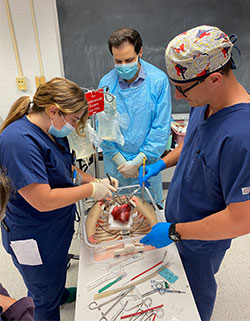Curriculum

The University of Rochester utilizes a balanced approach to training the future Cardiothoracic Surgeon. The program uses a mixture of both didactic and clinical service educational experiences, combined with an immersive simulation curriculum, to ensure that our graduates are technically and intellectually capable, mature surgeons.
Approximately 2500 index cases are performed each year providing each resident with the necessary operative experience required by the American Board of Thoracic Surgery to matriculate into competent, autonomous surgeons.
First Two Years
The first two years of training are designed to provide a concrete foundation in medical, surgical, and intensive care experience essential to the practice of Cardiothoracic Surgery. Residents work under supervision, alongside senior residents and attending physicians from General Surgery, Cardiac Surgery, Thoracic Surgery, and Anesthesia. The length of the rotations are designed to coincide with the General Surgery training program but are assigned to maximize operative experience in General, Vascular, and Cardiothoracic Surgery. At the conclusion of the second year, each resident chooses an emphasis/track in either Cardiac or Thoracic Surgery.
Third Year
The third year is composed of four (4) months of General Surgery, five (5) months of Cardiothoracic Surgery, and the remainder of time gaining experience in related fields. Those choosing a Cardiac track will spend time in the catheterization and echocardiography laboratories. Those choosing a General Thoracic track will spend time in the esophageal diagnostic and endoscopic laboratory with additional rotations on the Medical & Radiation Oncology services.
Final Three Years
The final three years of training are devoted to the surgical, percutaneous, and minimally invasive treatment of acquired and congenital cardiac disease as well as thoracic and esophageal disease. The rotations are designed so that residents rotate through Cardiac and Thoracic Surgery each year with increasing progressive responsibility and autonomy that culminates with the chief resident year.